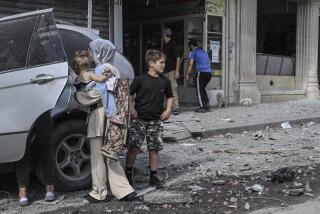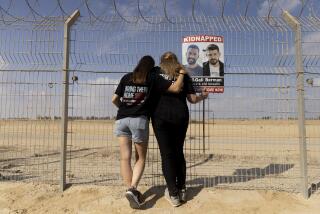We Still Face the Menace of Iraq’s Hidden Horrors
- Share via
Saddam Hussein’s regime has been deposed, and the world is slowly losing interest in Iraq’s weapons of mass destruction. There are even some who suggest the weapons don’t exist. But this is dangerous. If they still exist -- as much evidence indicates -- those weapons could make their way into the wrong hands. And the time to prevent this is growing short.
Before the Iraq war, chief U.N. weapons inspector Hans Blix said Iraq might still possess 10,000 liters of anthrax and 15 times the amount of gaseous gangrene-causing agent that it had declared to the inspectors. Both these deadly items would still be viable today if properly stored. Blix also pointed to new evidence that Iraq could have 6,500 more chemical weapon warheads than previously thought.
And let’s not forget that when U.N. inspectors left Iraq in 1998, they had compiled a frightening catalog of Iraq’s undeclared poison gas, including almost four tons of missing VX, the deadliest form of nerve gas, and at least 600 tons of ingredients to make more of it. Also unaccounted for were up to 3,000 tons of other agents like tabun, sarin and mustard gas, about 550 artillery shells filled with mustard gas and about 31,000 chemical munitions, both filled and empty.
There’s more. A classified CIA report prepared last spring and leaked to the press in November reported for the first time that the agency had “high” confidence that Iraq possessed smallpox. Add to this the mobile biological weapons labs described by U.S. Secretary of State Colin Powell before the U.N. Security Council in February. Two or three such trailers side by side could produce enough dried anthrax and botulinum toxin in a month to kill thousands of people. The United States has found only two trailers out of the total of 18 that Powell claims Iraq has. Those two are still being tested to verify what they were used for.
And there is Saddam Hussein’s pursuit of nuclear weapons. Iraq never turned over drawings showing its latest nuclear weapons design to the first inspection teams. In 1998, Iraq tried to buy 120 high-precision electronic switches, ostensibly for medical purposes, which are also used to trigger atomic bombs. And though suppliers claim to have provided only eight, sources at the United Nations and in the U.S. government believe that the number supplied was higher.
Not to worry, says Undersecretary of Defense Douglas Feith. In congressional testimony last week he predicted that the process of finding this vast catalog of banned weapons could take “months and perhaps years.” Time, the administration claims, will provide a clear picture of Iraq’s programs for weapons of mass destruction. Yet time is exactly what we don’t have.
Each day brings new stories of looting at sensitive weapons sites in Iraq, disappearing documents and under-resourced search teams, incapable of protecting even the sites we know about. Consider the sprawling Tuwaitha nuclear complex south of Baghdad, the main repository of Iraq’s known nuclear material and equipment. Coalition troops have been neither willing nor able to keep looters out. As a result, documents and equipment that could have provided evidence of Iraq’s nuclear ambitions have disappeared.
Tuwaitha houses at least 13 metric tons of natural uranium and 1.8 metric tons of low- enriched uranium, as well as significant quantities of cesium, strontium and cobalt. These last three nuclear isotopes would be ideal for use in a “dirty bomb.” And further processing of Iraq’s partially enriched uranium, in neighboring Iran for example, could produce enough weapons-grade uranium to fuel up to three nuclear weapons.
In April, the New York Times reported that U.S. weapons experts searching an ammunition complex near Karbala found manuals and packaging for two drying ovens imported from Germany, but no ovens. These ovens, said the Times, could be used to process viruses and bacteria for germ weapons. The Times also reported that the team found 11 buried containers with sophisticated lab equipment and seven canisters of cesium in a warehouse. Taken together, these items sketch a suspicious picture that will remain forever incomplete because of looting.
And what of the sites we don’t know about? Think back to the period after the 1991 Gulf War when U.N. inspectors discovered the extent of Iraq’s hidden nuclear activities. The Iraqis were running a secret program at Tarmiya configured to produce weapons-grade uranium; they were turning out uranium oxide at Al Jesira; and they had a vast nuclear weapon production facility at Al Atheer. Similar unknowns could exist in Iraq today. Our odds of finding them intact are falling by the hour.
To solve the Iraqi weapons puzzle, we need to throw everything we have at the problem, which means more troops for better site security and more inspectors who know what they’re looking for. We should also use the experience of the United Nations, which has the best lists of what Iraq had and where it was. In particular, the nuclear inspectors need to get back in as quickly as possible.
As long as uncertainty remains as to the location and quantity of Hussein’s mass- destruction arsenal, the threat to our security has not disappeared; it has only shifted. Until these weapons are accounted for, the war to disarm Iraq will not be won.
More to Read
Sign up for Essential California
The most important California stories and recommendations in your inbox every morning.
You may occasionally receive promotional content from the Los Angeles Times.










